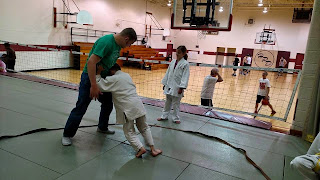Back in 1959 a man by the name of Walter Tevis
wrote the finest book on sport motivation yet to be printed. Now, it's not so surprising that a person
might endeavor to write on the subject of competitive motivation. Nor is it surprising that the book might get
published. What is surprising is that
the man was an English teacher and he wrote about the game of Pool! That's right, the fifteen ball, back alley, smoky room variety.
Walter Tevis did not
write just any book about pool. He wrote
about the highest possible levels of the game, the games where the players
don't miss; The games where vast amounts of money ride on the most difficult of
shots; The games where control was the most important factor. Control, physical and mental. Walter Tevis wrote a book called "The
Hustler". It became a movie and was
nominated for academy awards for the fine performances of Paul Newman, Jackie
Gleason and George C. Scott.
Undoubtedly, the reader
is asking what a pool player could have to do with Judo? What does a novel have to do with real
life? What could an English teacher show
me about teaching Judo? Bear with me,
while I explain.
The pertinent point of
the story centered around the inability of the lead character, Fast Eddie, to
maintain a winning attitude. It fell to the Hairy Legs Burt (pool room parlance
for, what might be considered, today's coach), to educate Eddie on the finer
points of winning. Burt had to teach
Eddie that winning, in-and-of itself, is easy.
The person who prepares properly wins!
It's that simple. What is not so
simple is overcoming the desire to lose.
Who on earth would want
to lose? Everybody wants to lose! The question is, why?
When you get down to it
losing is the way to go. When you lose
you get a lot of extra attention. The
loser doesn't stand-out, he doesn't have any pressure or responsibilities. He just has to go out and lose a match,
probably would have lost anyway, right?
So why bother? On the other hand,
to win and keep on winning you have to work, you have to maintain your
concentration. You have to accept
responsibility. After all, the winner
has the responsibility of setting an example by which the loser lives
vicariously.
Everybody consoles the
loser. Everybody lets him know that they know just how he feels. Everybody
tries to make him feel better. What they
are doing is letting the loser know that he is one of them, that he
belongs. Isn't that one of our deepest
and most basic needs, to belong? So why
mess it up by all that fuss about winning?
Just go out and make it look good.
But not too good, don't forget, the other guy is trying to lose too.
Winners are treated
differently! The winner is
congratulated, put on a pedestal, kept at a distance. After all, a winner is different. Common participants don't know how to relate
to the winner. They resent the fact that
the winner has the unmitigated gall to be better, to strive for a higher level,
to disturb the calm surface of every day mediocrity. But then, we can't treat the Winners too
harshly! Who are we going to get to
defeat the losers? Where else can we get
our vicarious thrills? The Winner serves
his purpose, so keep him around. Still,
deep inside, there is the spark of greatness, the will to win is in all of
us. The problem is overcoming the fear
of breaking away from the loser's syndrome.
Burt tried to explain
this to Eddie in simple terms. Tried to
impress upon Eddie that the most difficult opponent is yourself. Yes, yourself! Every time you realize you’re beginning to
pull away from the loser's attitude there’s a moment of panic. A moment when you realize that to stay on
course will be a step in the direction of forfeiting the approval of the other
losers, a step in the direction of becoming an individual.
Fortunately these
moments are easily recognized. They come
hard on the heels of a compliment from a spectator or another player. It's the moment when someone says to you
"nice move" or "good attack" and you say to yourself
"yes it was". At this point a
little voice lets you know that you've gone far enough! You've impressed the other losers, don't
carry things too far. Everybody knows
you're good, if they think you're too good you can't be one of them. This is the enemy! The voice of mediocrity is imploring you to
stay with the fold. It's warm and safe
here, there's no need to risk your nice safe position. This is the voice that the winner must
silence time and again.
Because we're third
party observers to Fast Eddie's thoughts we could see these things going
on. We see the struggle and the pitfalls
but wonder if this is applicable to ourselves.
When you stop and think about it, there's not a player or coach who
can't recall an incident that meets these circumstances. At some time or other each of us has had the
upper hand and backed off. Perhaps you
didn't realize what had happened, or why ,but Burt knew and he made Eddie a
winner by making Eddie understand.
Applying this to Judo
is the same as applying it to pool. We
need to understand that the normal tendency is to lose. After-all winning is hard work with dubious
rewards.
If winning is, indeed,
foreign, then our objective should not be to win. We need to learn to concentrate on specific
objectives. Work to accomplish a certain goal.
Cut the variables to a minimum by working toward small advantages. Keep your objectives in mind! If you are occupied with specific goals it is
difficult to be distracted by the voice of mediocrity.
Above all, you must
accept that it is right to strive to fulfill your potential! Remember, no one
else will ever know if you back off at the crucial moment. No one, that is,
except you and the other losers, and that's what they want.



























